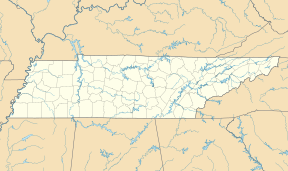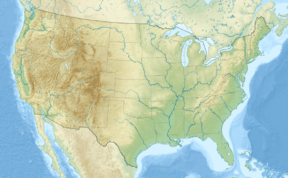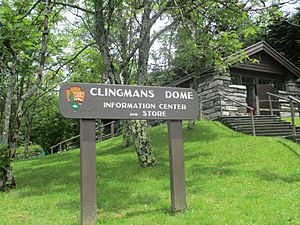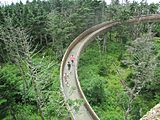Clingmans Dome facts for kids
Quick facts for kids Clingmans Dome |
|
|---|---|

Clingmans Dome, with the lookout tower and Spruce-fir forest
|
|
| Highest point | |
| Elevation | 6,643 ft (2,025 m) |
| Prominence | 4,503 ft (1,373 m) |
| Listing |
|
| Geography | |
| Location |
|
| Parent range | Great Smoky Mountains |
| Topo map | USGS Clingmans Dome |
| Climbing | |
| Easiest route | Short paved trail hike |
Clingmans Dome is a tall mountain in the Great Smoky Mountains. It sits on the border between Tennessee and North Carolina in the southeastern United States.
Standing at 6,643 feet (2,025 m) high, it is the highest point in the entire Great Smoky Mountains National Park. It is also the highest spot in Tennessee. Plus, it's the highest point along the long 2,192-mile (3,528 km) Appalachian Trail. Clingmans Dome is the third highest mountain in eastern North America. Only Mount Mitchell (6,684 feet or 2,037 metres) and Mount Craig (6,647 feet or 2,026 metres) are taller.
Contents
What is Clingmans Dome Like?
Clingmans Dome has two smaller peaks nearby. These are Mount Buckley to the west and Mount Love to the east. Many important streams start on the sides of Clingmans Dome. These include the Little River and Forney Creek. All the water from the mountain flows into the Tennessee River.
The mountain is part of the beautiful Great Smoky Mountains National Park. You can drive a paved road to get close to the top. This road connects to U.S. Highway 441. At the summit, there's a 45-foot (14 m) concrete observation tower. It was built in 1959. From the tower, you can see amazing views of the mountains all around.
The forest on Clingmans Dome is a special kind called a spruce-fir forest. These forests only grow at very high places in the southeastern U.S. They are more like forests you would find in colder, northern areas. Sadly, many Fraser fir trees on the mountain have died. This is because of a tiny insect called the balsam woolly adelgid.
Mountain's Past: Clingmans Dome History
The Cherokee people had their own name for Clingmans Dome. They called it Kuwa'hi, which means "mulberry place." An old Cherokee story says the mountain was home to the White Bear. This bear was the great chief of all bears. It was also where bears held their special meetings. The Cherokee also believed in a magical lake nearby. Its waters could heal wounded bears.
In 1789, the land that is now Tennessee was given to the U.S. government. The border between North Carolina and this new land was set along the "Great Iron or Smoky Mountains." This line included the mountain we now call Clingmans Dome.
Early American settlers called the mountain "Smoky Dome." But in 1859, it got its current name. A man named Arnold Henry Guyot renamed it after Thomas Lanier Clingman. Clingman was a general who explored the area in the 1850s. He spent many years telling people about the region. Guyot named the mountain for Clingman because of a disagreement. Clingman and a professor named Elisha Mitchell argued about which mountain was the highest. Mitchell thought a peak called Black Dome (now Mount Mitchell) was the tallest. Clingman believed Smoky Dome was the highest. Guyot measured them both. He found that Black Dome was 39 feet (12 m) taller than Smoky Dome.
On June 12, 1946, a Boeing B-29 Superfortress airplane crashed near the top of Clingmans Dome. All twelve people on board died.
How Clingmans Dome Was Formed
Clingmans Dome is made of very old rocks. These rocks are part of a group called the Copperhill Formation. They are mostly made of a type of rock called metagreywacke and metaconglomerate. These rocks formed about 560 million years ago. They were created from sand and pebbles that settled in deep basins. These basins formed when the Earth's crust pulled apart.
Over millions of years, these rocks were changed by heat and pressure. This process is called metamorphism. It happened during several mountain-building events. These events caused the rocks to fold and push upwards. This is how the Appalachian Mountains were formed. Even today, the mountains are still slowly rising and wearing away.
You can see some of these rocks at the Forney Ridge Parking Lot. Here, you can find large pieces of metaconglomerate. These rocks have pebbles and other small stones inside them.
Visiting Clingmans Dome
Clingmans Dome is one of the easiest mountain tops to reach in the Great Smoky Mountains National Park. The 7-mile (11 km) Clingmans Dome Road takes you almost to the top. This road is open from April 1 to November 30 each year. It ends at the Forney Ridge Parking Area, which is 300 feet (91 m) below the summit.
From the parking lot, a paved trail leads to the observation tower. This trail is about half a mile (800 m) long. It is a bit steep, but there are benches along the way to rest. At the top, you'll find a small visitor center and restrooms. The trail goes through the spruce-fir forest. You might see some dead Fraser fir trees along the path.
The famous Appalachian Trail also crosses Clingmans Dome. It passes right next to the observation tower. You can hike about 7.5-mile (12.1 km) from Newfound Gap to reach the mountain on this trail. This is the only way to get to the mountain in winter. Clingmans Dome is also the starting point for other hiking trails. These include the Forney Ridge Trail and the Forney Creek Trail.
The western end of the Mountains-to-Sea Trail is also on Clingmans Dome. This trail connects the Smokies all the way to the Outer Banks of North Carolina.
Clingmans Dome Observation Tower
|
Clingmans Dome Observation Tower
|
|
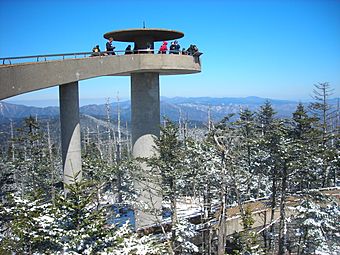 |
|
| Area | 1.4 acres (0.57 ha) |
|---|---|
| Built | 1959 |
| Architect | Bebb and Olson |
| Architectural style | Modern |
| NRHP reference No. | 12000515 |
| Added to NRHP | August 15, 2012 |
The observation tower was built in 1959. It is 45-foot (14 m) tall and made of concrete. To reach the top, you walk up a spiral ramp. The ramp is 375 feet (114 m) long and gently slopes upwards.
At the top, the platform is 28 feet (8.5 m) wide. It gives you a full 360-degree view of the mountains. There are signs that point out different peaks, cities, and other features you can see. On clear days, you can see up to 100 miles (160 km) away. On hazy days, visibility might be around 20 miles (32 km).
The tower was part of a program called Mission 66. This program helped national parks update their buildings after World War II. The tower's modern design was different from older park buildings. It used a lot of concrete. Some people thought it looked too "urban." But two other park towers were built with similar designs.
The tower cost $57,000 to build in 1958. Construction started in December 1958 and finished on October 23, 1959.
Weather at Clingmans Dome
The weather on Clingmans Dome is cool, like places farther north. It is part of what is called the Appalachian temperate rainforest. This means it gets a lot of rain.
| Climate data for Clingmans Dome | |||||||||||||
|---|---|---|---|---|---|---|---|---|---|---|---|---|---|
| Month | Jan | Feb | Mar | Apr | May | Jun | Jul | Aug | Sep | Oct | Nov | Dec | Year |
| Mean daily maximum °F (°C) | 35 (2) |
35 (2) |
39 (4) |
49 (9) |
57 (14) |
63 (17) |
65 (18) |
64 (18) |
60 (16) |
53 (12) |
42 (6) |
37 (3) |
50 (10) |
| Daily mean °F (°C) | 27.0 (−2.8) |
26.5 (−3.1) |
31.5 (−0.3) |
41.5 (5.3) |
50.0 (10.0) |
56.0 (13.3) |
59.0 (15.0) |
58.0 (14.4) |
53.5 (11.9) |
45.5 (7.5) |
35.0 (1.7) |
29.0 (−1.7) |
43.0 (6.1) |
| Mean daily minimum °F (°C) | 19 (−7) |
18 (−8) |
24 (−4) |
34 (1) |
43 (6) |
49 (9) |
53 (12) |
52 (11) |
47 (8) |
38 (3) |
28 (−2) |
21 (−6) |
36 (2) |
| Average precipitation inches (mm) | 7.0 (180) |
8.2 (210) |
8.2 (210) |
6.5 (170) |
6.0 (150) |
6.9 (180) |
8.3 (210) |
6.8 (170) |
5.1 (130) |
5.4 (140) |
6.4 (160) |
7.3 (190) |
82.1 (2,100) |
| Average snowfall inches (cm) | 18 (46) |
20 (51) |
26 (66) |
5 (13) |
trace | 0 (0) |
0 (0) |
0 (0) |
trace | 2 (5.1) |
5 (13) |
8 (20) |
84 (214.1) |
Gallery
-
Mountains north of the observation tower obscured by low clouds.
See also
 In Spanish: Clingmans Dome para niños
In Spanish: Clingmans Dome para niños


